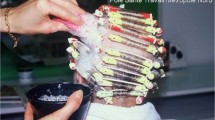Abstract
Purpose of Review
Skin permeability often increases in skin with impaired barrier function resulting in possibly a higher susceptibility to allergen minimal eliciting doses.
Recent Findings
This overview summarizes data to be utilized in dermatotoxicology by comparing the minimal eliciting allergic contact dermatitis concentrations (MEC) between normal and damaged skin. This serves to demonstrate the higher propensity to allergic elicitation in damaged skin and expands the industrial knowledge of the impact of allergens on damaged skin.
Summary
The data helps to determine reasonable safe exposure concentrations in cosmetic and skin care products.
Similar content being viewed by others
Data Availability
Not applicable.
References
Murphy PB, Atwater AR, Mueller M. Allergic contact dermatitis. 2022 Sep 19. In: StatPearls [Internet]. Treasure Island (FL): StatPearls Publishing; 2023 Jan.
Azizi N, Maibach HI. Are topical corticoids efficacious in acute irritant dermatitis: the evidence. Dermatitis. 2020 Jul/Aug;31(4):244-246. https://doi.org/10.1097/DER.0000000000000574. PMID: 32665512.
Jakasa I, de Jongh CM, Verberk MM, Bos JD, Kezić S. Percutaneous penetration of sodium lauryl sulphate is increased in uninvolved skin of patients with atopic dermatitis compared with control subjects. Br J Dermatol. 2006;155(1):104–9.
Agner T, Serup J. Sodium lauryl sulphate for irritant patch testing—a dose-response study using bioengineering methods for determination of skin irritation. J Invest Dermatol. 1990;95(5):543–7.
Jerschow E, Hostýnek JJ, Maibach HI. Allergic contact dermatitis elicitation thresholds of potent allergens in humans. Food Chem Toxicol. 2001;39(11):1095–108. https://doi.org/10.1016/s0278-6915(01)00059-x.
Nassau S, Fonacier L. Allergic contact dermatitis. Med Clin North Am. 2020;104(1):61–76. https://doi.org/10.1016/j.mcna.2019.08.012. (Epub 2019 Oct 28).
Jakasa I, Thyssen JP, Kezic S. The role of skin barrier in occupational contact dermatitis. Exp Dermatol. 2018;27(8):909–14. https://doi.org/10.1111/exd.13704.
Hindsén M, Bruze M. The significance of previous contact dermatitis for elicitation of contact allergy to nickel. Acta Derm Venereol. 1998;78(5):367–70.
Menné T. Quantitative aspects of nickel dermatitis. Sensitization and eliciting threshold concentrations. Sci Total Environ. 1994;148(2-3):275-281. https://doi.org/10.1016/0048-9697(94)90403-0.
Basketter D, Allenby F. A model to simulate the effect of detergent on skin and evaluate any resulting effect on contact allergic reactions. Contact Dermatitis. 1990;23:291.
Schmidt JD, Ahlström MG, Johansen JD, Dyring-Andersen B, Agerbeck C, Nielsen MM, Poulsen SS, Woetmann A, dum N, Thomsen AR, Geisler C, Bonefeld CM. Rapid allergen-induced interleukin-17 and interferon-γ secretion by skin-resident memory CD8(+) T cells. Contact Dermatitis. 2017 Apr;76(4):218-227.
Hauksson I, Pontén A, Gruvberger B, Isaksson M, Engfeldt M, Bruze M. Skincare products containing low concentrations of formaldehyde detected by the chromotropic acid method cannot be safely used in formaldehyde-allergic patients. Br J Dermatol. 2016;174(2):371–9.
Latorre N, Silvestre JF, Monteagudo AF. Allergic contact dermatitis caused by formaldehyde and formaldehyde releasers. Actas Dermosifiliogr. 2011;102(2):86–97.
De Groot AC, Flyvholm MA, Lensen G et al. Formaldehyde-relea- sers: relationship to formaldehyde contact allergy. Contact allergy to formaldehyde and inventory of formaldehyde-releasers. Contact Dermatitis 2009; 61:63–85.
Zaghi D, Maibach HI. Quantitative relationships between patch test reactivity and use test reactivity: an overview. Cutan Ocul Toxicol. 2008;27(3):241–8.
Acknowledgements
The authors wish to thank Dr. Aria Vazirnia for reviewing their manuscript.
Author information
Authors and Affiliations
Contributions
Nazanin Azizi: conceptualization, writing original draft (lead); Farnaz Azizi: writing, review and editing (equal). Le Hanh dung Do: review and editing (equal); Howard I Maibach: conceptualization, review and editing (equal).
Corresponding author
Ethics declarations
Ethical Approval
Not applicable.
Conflict of Interest
The authors have no relevant personal or financial relationship with any organization.
Human and Animal Rights and Informed Consent
This article does not contain any studies with human or animal subjects.
Additional information
Publisher's Note
Springer Nature remains neutral with regard to jurisdictional claims in published maps and institutional affiliations.
Rights and permissions
Springer Nature or its licensor (e.g. a society or other partner) holds exclusive rights to this article under a publishing agreement with the author(s) or other rightsholder(s); author self-archiving of the accepted manuscript version of this article is solely governed by the terms of such publishing agreement and applicable law.
About this article
Cite this article
Azizi, N., Azizi, F., Do, L.H.D. et al. Minimal Eliciting Allergic Contact Dermatitis Concentrations in Normal versus Damaged Skin: Clinical and Toxicologic Relevance. Curr Derm Rep 12, 296–299 (2023). https://doi.org/10.1007/s13671-023-00401-z
Accepted:
Published:
Issue Date:
DOI: https://doi.org/10.1007/s13671-023-00401-z




